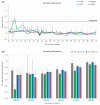Concomitant Swine Influenza A Virus Infection Alters PRRSV1 MLV Viremia in Piglets but Does Not Interfere with Vaccine Protection in Experimental Conditions
- PMID: 33917103
- PMCID: PMC8067798
- DOI: 10.3390/vaccines9040356
Concomitant Swine Influenza A Virus Infection Alters PRRSV1 MLV Viremia in Piglets but Does Not Interfere with Vaccine Protection in Experimental Conditions
Abstract
Modified-live vaccines (MLVs) against porcine reproductive and respiratory syndrome viruses (PRRSVs) are usually administrated to piglets at weaning when swine influenza A virus (swIAV) infections frequently occur. SwIAV infection induces a strong interferon alpha (IFNa) response and IFNa was shown to abrogate PRRSV2 MLV replication and an inherent immune response. In this study, we evaluated the impacts of swIAV infection on the replication of a PRRSV1 MLV (MLV1), post-vaccine immune responses and post-challenge vaccine efficacy at both the systemic and pulmonary levels. Piglets were either swIAV inoculated and MLV1 vaccinated 6 h apart or singly vaccinated or mock inoculated and mock vaccinated. Four weeks after vaccination, the piglets were challenged with a PRRSV1 field strain. The results showed that swIAV infection delayed MLV1 viremia by six days and post-vaccine seroconversion by four days. After the PRRSV1 challenge, the swIAV enhanced the PRRSV1-specific cell-mediated immunity (CMI) but the PRRSV1 field strain viremia was not better controlled. High IFNa levels that were detected early after swIAV infection could have been responsible for both the inhibition of MLV1 replication and CMI enhancement. Thus, whereas swIAV infection had a negative impact on humoral responses post-vaccination, it did not interfere with the protective effectiveness of the PRRSV MLV1 in our experimental conditions.
Keywords: interference; interferon; modified-live vaccine; porcine reproductive and respiratory syndrome; swine influenza A virus.
Conflict of interest statement
The authors declare no conflict of interest.
Figures











Similar articles
-
Protection provided by a commercial modified-live porcine reproductive and respiratory syndrome virus (PRRSV) 1 vaccine (PRRSV1-MLV) against a Japanese PRRSV2 field strain.J Vet Sci. 2023 Sep;24(5):e54. doi: 10.4142/jvs.23025. Epub 2023 Jul 7. J Vet Sci. 2023. PMID: 37638707 Free PMC article.
-
Maternally-derived neutralizing antibodies reduce vaccine efficacy against porcine reproductive and respiratory syndrome virus infection.Vaccine. 2019 Jul 18;37(31):4318-4324. doi: 10.1016/j.vaccine.2019.06.045. Epub 2019 Jun 24. Vaccine. 2019. PMID: 31248683 Free PMC article.
-
Successive Inoculations of Pigs with Porcine Reproductive and Respiratory Syndrome Virus 1 (PRRSV-1) and Swine H1N2 Influenza Virus Suggest a Mutual Interference between the Two Viral Infections.Viruses. 2021 Oct 27;13(11):2169. doi: 10.3390/v13112169. Viruses. 2021. PMID: 34834975 Free PMC article.
-
Gilt Vaccination with a Mixed Administration of a PRRS MLV and a PPV1 Subunit Vaccine Protects against Heterologous PRRSV1 Infection and Prevents Detrimental Effects on Piglet Performance.Viruses. 2020 Jul 23;12(8):789. doi: 10.3390/v12080789. Viruses. 2020. PMID: 32717833 Free PMC article.
-
Recombinant Porcine Reproductive and Respiratory Syndrome Virus Expressing Membrane-Bound Interleukin-15 as an Immunomodulatory Adjuvant Enhances NK and γδ T Cell Responses and Confers Heterologous Protection.J Virol. 2018 Jun 13;92(13):e00007-18. doi: 10.1128/JVI.00007-18. Print 2018 Jul 1. J Virol. 2018. PMID: 29643245 Free PMC article.
Cited by
-
Effect of vaccination route (intradermal vs. intramuscular) against porcine reproductive and respiratory syndrome using a modified live vaccine on systemic and mucosal immune response and virus transmission in pigs.BMC Vet Res. 2024 Jan 3;20(1):5. doi: 10.1186/s12917-023-03853-4. BMC Vet Res. 2024. PMID: 38172908 Free PMC article.
-
Testable Candidate Immune Correlates of Protection for Porcine Reproductive and Respiratory Syndrome Virus Vaccination.Vaccines (Basel). 2023 Mar 5;11(3):594. doi: 10.3390/vaccines11030594. Vaccines (Basel). 2023. PMID: 36992179 Free PMC article. Review.
-
Marine-Sulfated Polysaccharides Extracts Exhibit Contrasted Time-Dependent Immunomodulatory and Antiviral Properties on Porcine Monocytes and Alveolar Macrophages.Animals (Basel). 2022 Sep 27;12(19):2576. doi: 10.3390/ani12192576. Animals (Basel). 2022. PMID: 36230315 Free PMC article.
-
Impact of swine influenza A virus on porcine reproductive and respiratory syndrome virus infection in alveolar macrophages.Front Vet Sci. 2024 Aug 26;11:1454762. doi: 10.3389/fvets.2024.1454762. eCollection 2024. Front Vet Sci. 2024. PMID: 39253525 Free PMC article.
-
Simultaneous Infection With Porcine Reproductive and Respiratory Syndrome and Influenza Viruses Abrogates Clinical Protection Induced by Live Attenuated Porcine Reproductive and Respiratory Syndrome Vaccination.Front Immunol. 2021 Nov 11;12:758368. doi: 10.3389/fimmu.2021.758368. eCollection 2021. Front Immunol. 2021. PMID: 34858411 Free PMC article.
References
-
- Siddell S.G., Walker P.J., Lefkowitz E.J., Mushegian A.R., Adams M.J., Dutilh B.E., Gorbalenya A.E., Harrach B., Harrison R.L., Junglen S., et al. Additional changes to taxonomy ratified in a special vote by the International Committee on Taxonomy of Viruses (October 2018) Arch. Virol. 2019;164:943–946. doi: 10.1007/s00705-018-04136-2. - DOI - PubMed
-
- Martelli P., Gozio S., Ferrari L., Rosina S., De Angelis E., Quintavalla C., Bottarelli E., Borghetti P. Efficacy of a modified live porcine reproductive and respiratory syndrome virus (PRRSV) vaccine in pigs naturally exposed to a heterologous European (Italian cluster) field strain: Clinical protection and cell-mediated immunity. Vaccine. 2009;27:3788–3799. doi: 10.1016/j.vaccine.2009.03.028. - DOI - PubMed
Grants and funding
LinkOut - more resources
Full Text Sources
Other Literature Sources

